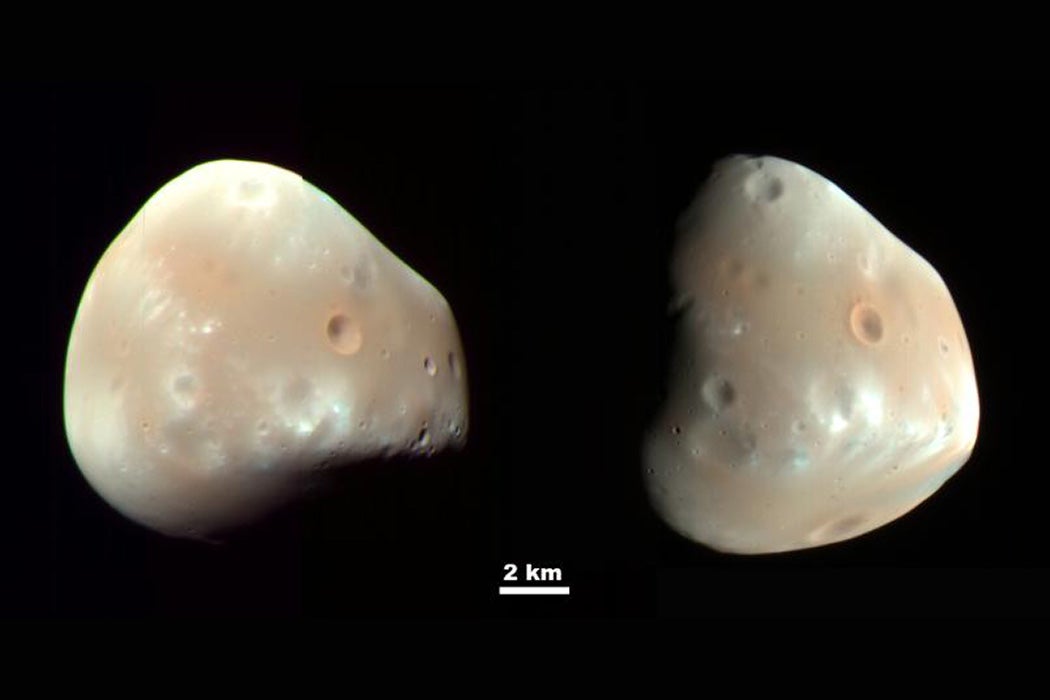So, it turns out there are new things under the Sun, right here in our solar system. One of Mars’s lumpy pair of moons looks like it may actually be a piece of Mars itself and not, as was long hypothesized, an asteroid captured by the fourth planet’s gravity.
The United Arab Emirates’s space probe Hope recently flew past the nearly eight-mile-wide Deimos and gave us our first look at the moonlet’s far side. The initial spectral analysis suggests Deimos is made out of Martian rock. As David Castelvecchi put it in Nature, “The relatively flat spectrum the scientists saw is suggestive of the type of material seen on Mars’s surface, rather than the carbon-rich rock often associated with asteroids.”
Science adapts to new data. Since the discovery of Mars’ satellites in 1877 by American astronomer Asaph Hall, people have looked at the available evidence and asked, “where did Mars get its moons?” Most have pointed to the asteroid belt that lies between Mars and Jupiter.
Take, for example, E. Miller’s paper, read before the Kansas Academy of Sciences on December 31, 1896. Exploring the orbital intersection of the asteroid 132 Aethra (discovered in 1873) with Mars’ orbital path, it looked to Miller as if this was a gravitationally correct way for Mars to snag a misshapen moon to its orbit.
“It may be affirmed with a reasonable degree of probability that the two moons of Mars, Deimos and Phobos, at one time in the far distant past were members of the asteroidal group,” he wrote. “Their size also seems to indicated their origin…”
That was the science of the day and for some time afterward. It fit what was known about the solar system’s structure and the working of gravity. As it happened, not much was actually known about the composition of Deimos, a tiny thing even in larger telescopes. The Hope flyby on March 10, 2023, the first of many by the probe, gave scientists new data to rearrange their ideas.
So what’s Mars’ other moonlet, Phobos, made out of? Hope doesn’t fly low enough to get a good multispectral look, so the question remains open.
The moons of Mars were named after the Greek God of War’s mythological offspring. Phobos, fear and panic, and Deimos, terror and dread, joined their father in the chaos of battle. Their afterparties were legendary.
Long before Asaph Hall spotted the moons with the US Naval Observatory’s telescope, it was speculated that the planet would possess exactly two of them. Craters on Deimos are named after two of the speculators, Jonathan Swift (in Gulliver’s Travels, 1726) and Voltaire (in a short story, 1752). One of the designers of the USSR’s Venus and Mars probes would later wonder if Swift had inside information—from the Martians themselves.
Weekly Newsletter
In 1959, an April Fool’s joke engineered in the monthly newsletter of the Great Plains Astronomical Society by Sky & Telescope columnist Walter Scott Houston postulated that Mars’s two moons were artificial satellites. Soviet scientist Iosef Shklovsky took it at face value and expanded the notion, arguing that Deimos was a hollow metal sphere, the Red Planet’s own sputnik—sputnik being the Russian word for satellite. (According to Shklovsky’s CIA file, his argument was published in Komsomol’skaya Pravda on May 31, 1959.)
If, in fact, Deimos is a piece of Mars itself, it wouldn’t be the first time the Red Planet has thrown its weight (or is that mass?) around. The Earth has been hit at least 175 times by meteorites of Martian origin.
That long-promised invasion from Mars? It’s real, and it’s rocky.







